Missions of California (with Map) – All 21 California Missions from South to North
categories: Central Coast, Northern California, Southern CaliforniaI grew up in California where every 4th-grade student needs to learn about California history and needed, when I was a kid, to make a model of one of the missions of California. For those of you who didn’t here is a guide to the 21 missions that the Spanish built in what is now California.

Mission San Juan Bautista
Table of contents: ()
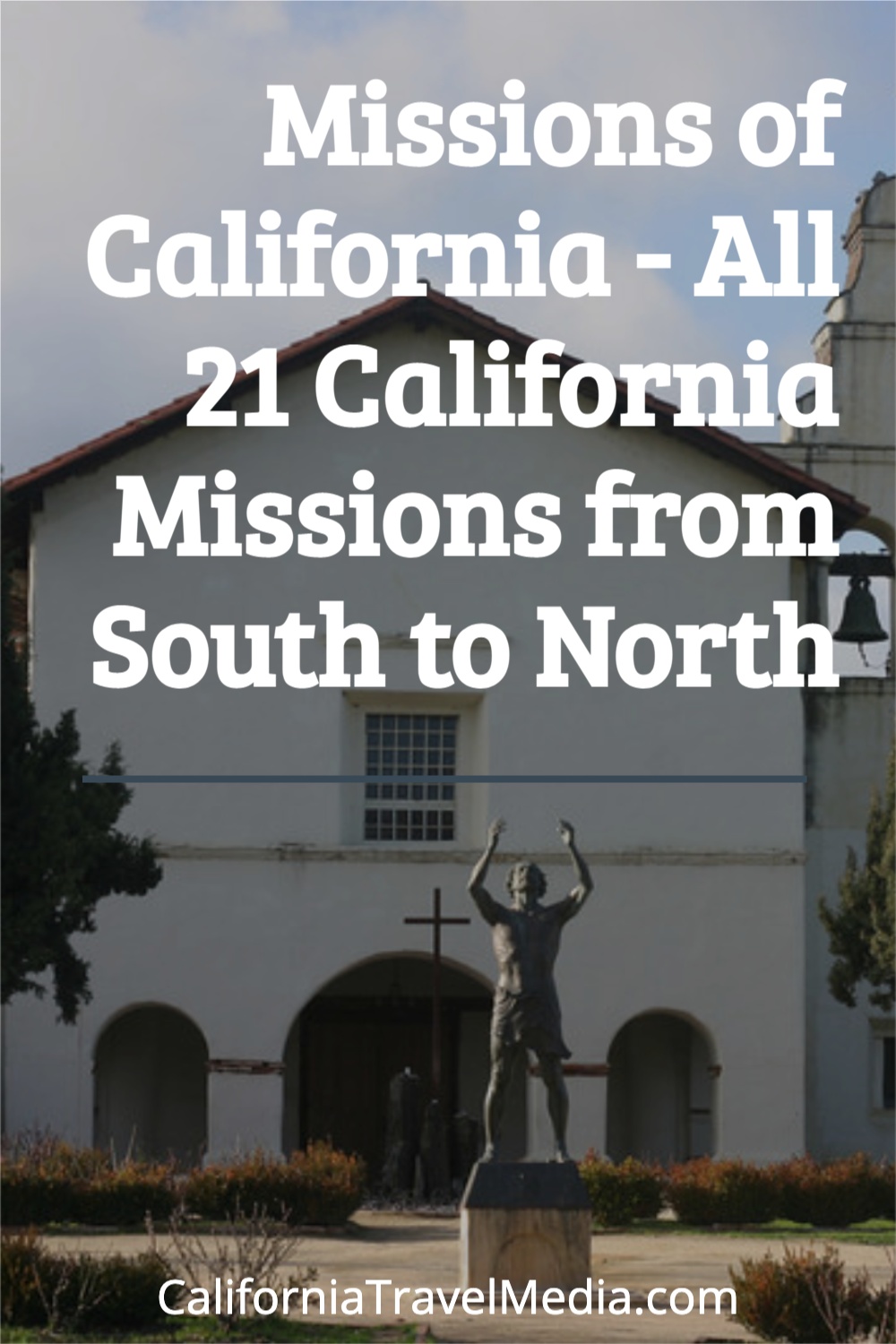
- California Mission History
- Missions of California Map
- Mission San Diego de Alcala – San Diego
- Mission San Luis Rey de Francia – San Luis Rey
- Mission San Juan Capistrano – San Juan Capistrano
- Mission San Gabriel Arcangel – San Gabriel
- Mission San Fernando Rey de Espana – Mission Hills
- Mission Basilica San Buenaventura – Ventura
- Mission Santa Barbara – Santa Barbara
- Mission Santa In̩s РSolvang
- Mission La Purisima Conception – Lompoc
- Mission San Luis Obispo de Tolosa – San Luis Obispo
- Mission San Miguel Arcangel – San Miguel
- Mission San Antonio de Padua – Jolon
- Mission Nuestra Senora de la Soledad – Soledad
- Mission San Carlos Borromeo de Carmelo – Carmel
- Mission San Juan Bautista – San Juan Bautista
- Mission Santa Cruz – Santa Cruz
- Mission Santa Clara de Asis – Santa Clara
- Mission San Jose – Fremont
- Mission San Francisco de Asis, Mission Dolores – San Francisco
- Mission San Rafael Arcangel – San Rafael
- Mission San Francisco Solano – Sonoma
California Mission History
When the Spanish wanted to settle what is now the state of California they sent soldiers and priests. The soldiers built forts or presidios in the strategic locations of San Diego, Santa Barbara, Monterey, and San Francisco. The priests built a series of missions that stretch from what is now the border with Mexico to Sonoma. The missions were part of a longer chain of missions that started in Baja California with the founding of the mission in Loreto, Mexico by Father Juan MarÃa Salvatierra in 1697. That line of missions extended into Alta California in 1769 led by Franciscan Father (now Saint) JunÃpero Serra.
These missions were self-sufficient communities where the friars and sometimes thousands of native converts (neophytes) would cultivate the land. Some of these missions became the nucleus around which California cities like Los Angeles, Santa Clara, San Francisco, or Sonoma would build. Some of these missions were ignored by later town planners. Some like Mission Soledad will be found in the middle of a farmer’s field. All of California’s missions were closed when Mexico ruled California. Between 1834 and 1836 all of California’s missions were closed and the mission fathers were evicted. While the idea was to return much of the land to the native people, in reality, it created a series of rich ranch owners who bought or were given the land.
These days most of the missions are again Roman Catholic parishes. Some are state parks. All of the missions were in ruin at one time but have since been restored or reconstructed.
Missions of California Map
Mission San Diego de Alcala – San Diego
Founded: July 16, 1769
Order of creation: 1st mission
Status: Roman Catholic church
Location: 10818 San Diego Mission Rd., San Diego
Landmarks in California were sometimes named by the Spanish after the saint whose feast day was closest to the day of discovery. San Diego was originally named San Miguel when the explorer Juan RodrÃguez Cabrillo saw it in 1542 near the feast day of Saint Michael the Archangel, but when the explorer Sebastian Viscaino returned to the bay in 1602 it was closer to the feast day of Saint Didacus of Alcalá and so it was renamed, San Diego. Saint Didacus was a Franciscan missionary who brought Christianity to the Canary Islands in the 1400s. So when the Franciscan Friars Serra, Parron, and Palou founded the first church in what would become California, they named it, as it turns out, for one of their missionary predecessors.
This is not the original site of the mission. It was founded on an area overlooking the harbor but a lack of freshwater caused the fathers to move the mission inland 5 years after it was founded. 5 different parties were dispatched from Mexico to found this mission. 3 came by ship and 2 by land. Of the 219 colonists in the first 4 groups, near half of them died on the way or shortly after arriving. The biggest killer was scurvy. Father Serra came with the 2nd land party. He was 56 years old at the time, 5′ 2″ tall, 120 pounds and walked with a limp. It was perhaps not the most auspicious start.
The mission (then in ruins) was returned to the Roman Catholic church on May 23, 1862, by President Lincoln.
Notable: This mission is not only the oldest mission, and therefore the oldest surviving structure in the state, but also has the first historic cemetery. The mission also has a garden with trees that date back to the time of the early missionaries.
Mission San Luis Rey de Francia – San Luis Rey
Founded: June 13, 1798
Order of creation: 18th mission
Status: Roman Catholic church, National Historic Landmark
Location: 4050 Mission Ave., San Luis Rey
This mission was named for Saint and King of France Louis IX. Louis IX led the 7th and 8th crusades in the 1200s and died while on the 8th crusade. It is one of two mission named for a king and was also one of the largest and most prosperous, giving San Luis Rey de Francia the moniker the “King of the Missions”. It was founded by fathers Antonio Peyrà and José Faura. The mission was occupied by the U.S. Army for sometime before it was returned to the church in 1865. But then the mission sat derelict for some years before it was restored in 1892. The current church which seats 1000 people was the 3rd one constructed at the mission and was built in 1815. There is also a large (6 acre) central square in the mission complex.
Notable: The gardens contain the first pepper tree planted in California which was transported from Peru.

Mission San Juan Capistrano – San Juan Capistrano
Founded: November 1, 1776
Order of creation: 7th mission
Status: Non-Profit
Location: Ortega Hwy. at Camino Capistrano, San Juan Capistrano
This mission is the start of what became Orange County California. In November of 1775, the first mission was destroyed by a Kumeyaay war party only a month after it was founded.
It was founded for good by Father Serra in 1776, but that was not the end of its ill-fortune. A great stone church was finished in 1806 which was considered the Jewel in the Crown of the California Missions. It was destroyed only 6 years later in 1812 by an earthquake. The earthquake killed 40 worshippers and a couple of bell-ringers.
It is named for the Italian warrior saint John of Capistrano who led a crusade against the Ottoman Empire at the siege of Belgrade in 1456 when he was 70 years old.
The mission was given back to the Roman Catholic Church by Lincoln in 1865 and the church still owns the land but the mission is run by a non-profit organization.
Notable: The mission is known for the annual migration of swallows from Mexico and Central America on March 19th. Urbanization has significantly decreased the number of swallows which used to number 6,000 at a time. In 2012, the mission started a project to attract the swallows back which includes bird calls and a stationary nest wall.
Notable: The mission is the only surviving church where Father Serra said mass.
Mission San Gabriel Arcangel – San Gabriel
Founded: September 8, 1771
Order of creation: 4th mission
Status: Roman Catholic Church
Location: 428 South Mission Drive, San Gabriel, 91776
Mission San Gabriel Arcangel was founded on the hills north of modern-day Montebello but moved to its current location in 1775. Although named after an angel, just like Los Angeles, this mission is 8 miles east of downtown LA. This was one of the most prosperous of all the missions and once controlled a quarter of the livestock and grain of the whole mission system. At its peak in 1829, the mission’s herds included 25,000 cattle and 15,000 sheep.
It is patterned after a Moorish fortress similar to the style of the Cathedral in Córdoba, Spain. It was founded by Fathers Serra, Pedro Benito Cambón, and Angel Fernandez Somera y Balbuena. It was at this mission that Fr. José Zalvidea introduced the first of California’s large scale vineyards.
The first American to reach Alta California by land was Jedediah Smith, who was welcomed to Mission San Gabriel Arcangel in 1826. The mission was returned by President James Buchanan in 1859.
The roof of the original mission was destroyed by fire on July 11, 2020.
Notable: It has stations of the cross which were painted by Native American converts.
Mission San Fernando Rey de Espana – Mission Hills
Founded: September 8, 1797
Order of creation: 17th mission
Status: Roman Catholic Church
Location: 15151 San Fernando Mission Blvd., Mission Hills, 91345
If you want your mission to be well regarded, it does not hurt to name it after the king. This mission is named in honor of King Ferdinand III of Spain (also the Archduke of Austria, King of Hungary, Croatia, and Bohemia, and Holy Roman Emperor). King Ferdinand was pretty important. The Convento, pictured above, has a colonnade with 19 arches and is the largest freestanding adobe building in California.
This is a large mission and at its peak in 1829 it had large herds of cattle (12,800 ) and sheep (5,000) and a population of around 1,000 people. The first California Gold strike happened on one of the mission’s ranches in 1842 and the mission was damaged by people looking for gold that they thought (mistakenly) was hidden in the walls by the padres.
The church began having services again in 1923 and the mission was restored in the 1940s. The mission needed to be rebuilt again after the damage done to it by the 1971 San Fernando earthquake.
Notable:
- Brand Park across the street from the mission has a statue of Father Serra.
- Comedian Bob Hope and his wife Delores are buried in the Bob Hope Memorial Gardens on the grounds. Hope converted to Catholicism 7 years before his death.
Admission:
- Adults: $5.00
- Children (ages 7-15): $3.00
Mission Basilica San Buenaventura – Ventura
Founded: Easter Sunday, March 31, 1782
Order of creation: 9th mission
Status: Roman Catholic Church
Location: 225 E. Main St., Ventura, 93001
The mission was named in honor of philosopher, scholar, and Saint Bonaventure who lived in Italy in the 1200s. Buenaventura was an early leader of the Franciscans who founded California’s missions. The church was named as a minor basilica by Pope Francis in 2020. This is the last of the six missions dedicated by Father Serra. It was originally planned to be the 3rd mission but was delayed because of a shortage of military escorts. The current church is the 3rd on the site.
The first mission was only 3 blocks from the ocean which has had some drawbacks. In 1812 it had to be abandoned briefly after an earthquake and a subsequent tidal wave. Both Mission San Juan Capistrano and San Buenaventura were attacked in 1818 by an Argentinian Pirate Hippolyte de Bouchard.
The mission was known for its elaborate water distribution system and gardens until they were destroyed by floods in 1860. The mission was returned to the Catholic church by President Abraham Lincoln in 1862.
Notable: The mission museum holds two old wooden bells which are unique in the mission system.

Mission Santa Barbara – Santa Barbara
Founded: December 4, 1786
Order of creation: 10th mission
Status: Roman Catholic Church
Location: 2201 Laguna St., Santa Barbara, 93105
When Father Serra died in 1784, Father FermÃn Lasuén took charge of the California missions. He would keep that role for 4 years longer than Father Serra. Santa Barbara was the first of the missions that he established. It is often called the “Queen of the Missions”.
The current mission is the 4th to have been built on the location. It was built in 1820 after the 3rd adobe church was heavily damaged by an earthquake in 1812. It needed major rebuilding after another strong earthquake struck just 5 years later in 1825.
The mission was founded on the feast day of Saint Barbara who was an early Christian martyr from modern-day Lebanon. She is the patron saint of those who work with explosives: armorers, artillerymen, military engineers, miners. The legend goes that Barbara was beheaded for her faith with her father actually carrying out the sentence. She became associated with things that explode because on his way home her father was struck by lightning and burned up.
Many of the stories of Saint Barbara are more legend than history so in the 1960s the Catholic church removed her feast day from their calendar, but she still has this mighty fine mission named after her.
When the missions were secularized in 1833, the archives of all the California missions were moved to Mission Santa Barbara. The mission was restored to the Franciscans (rather than the local diocese) in 1865 by Abraham Lincoln. It is still home to a community of Franciscan Friars.
Notable: Next door to the mission is the city’s Mission Historical Park where you can see ruins of some of the original facilities such as the tanning vats and aqueduct.

Mission Santa In̩s РSolvang
Founded: September 17, 1804
Order of creation: 19th
Status: Roman Catholic Church, National Historic Landmark
Location: 1760 Mission Drive • Solvang, CA 93463
Old Mission Santa Inés is one of the best-preserved of the missions which is one of the reasons that it is a National Historic Landmark. It is a very Spanish looking building in the very Danish looking town of Solvang.
Mission Santa Inés (or Santa Ynez) was founded by Fr. Estévan Tapis on September 17, 1804. Like the other local missions, it also had to be rebuilt after the 1812 earthquake. Many of the native Chumash left after a rebellion in 1824 started by the beating of a local Chumash young man at the hands of a Mexican soldier. In 1844, it became the site for the first seminary in California. It was returned to the Catholic church in 1962 by president Lincoln.
The mission is named for St Agnes of Rome who was a virgin who was martyred in 304 A.D. at the age of only 12 or 13. The story goes that she was condemned when she refused the advances of a rich young man. She is considered the patron saint of betrothed couples and virgins.

Mission La Purisima Conception – Lompoc
Founded: December 8, 1787 – Feast of the Immaculate Conception
Order of creation: 11th mission
Status: La Purisima Mission State Historic Park, National Historic Landmark
Location: 2295 Purisima Rd., Lompoc, 93436
Founded by Father FermÃn Lasuén, this mission was founded on the feast day of the Immaculate Conception so the full name of the mission translated is “Mission of the Immaculate Conception of the Most Blessed Virgin Mary”. It was originally founded closer to the present city of Lompoc but was destroyed by the 1812 earthquake. When it was rebuilt, the mission was moved into the hills.
Because it was not incorporated into a town it is the best example of the complete mission complex. You can still see the layout where the pottery shop, blacksmith, Indian barracks, kitchens, tallow vats, etc were located. It was designated a National Historic Landmark in 1970.
All the missions had similar ranches and outbuildings at one time. The tallow vats recall a time when the missions had large herds of cattle but limited markets for goods. In the early 1800s, the missions sold the hides and tallow (rendered fat) from their cattle which were shipped “around the Horn” to the East Coast. It was not practical at that time to ship meat those distances. If you are interested in reading more about Mexican California and the hide business I would recommend the classic book Two Years Before the Mast.
It is one of only two missions that have no current connection with the Catholic Church.
Notable: The mission is part of a large (1,934-acre) park with numerous hiking trails.
Day Use Parking Fees:
- $6.00 per vehicle
- $5.00 – for Seniors (62 and over) per car

Mission San Luis Obispo de Tolosa – San Luis Obispo
Founded: September 1, 1772
Order of creation: 5th mission
Status: Roman Catholic Church
Location: 782 Monterey St., San Luis Obispo, 93401
The 5th mission in the system was founded in 1772 by Father Serra and named in honor of Saint Louis of Anjou. Louis was the son of the king of Naples who was a hostage for 7 years after his father lost a war to the King of Aragon. During that time he was educated by Franciscan friars. When he was freed and became his father’s heir on the death of his elder brother, he renounced the throne and took the Franciscan vows of poverty, chastity, and obedience instead. He became a bishop at a young age and was known for serving the poor and feeding the hungry. He only lived to the age of 23.
When the food supplied dwindled at the Monterey mission (the 2nd mission), Father Serra sent a hunting party to the “valley of the bears” which had been noted on the exploration of central California. The hunting party was so successful that Father Serra decided to build a mission in the area.
The original mission was burned down by local natives. The mission gained a tile roof when it was reconstructed because the natives had set fire to the original thatched roof.
Notable: The museum has a collection of historic photographs of California.
Mission San Miguel Arcangel – San Miguel
Founded: July 25, 1797
Order of creation: 16th mission
Status: Roman Catholic Church, National Historic Landmark
Location: 801 Mission St., San Miguel, 93451
Mission San Miguel Arcangel was founded by Father Lasuen and named for the Archangel Michael. One of the later missions, Mission San Miguel filled in the gap between Mission San Antonio and Mission San Luis Obispo. The idea was to make the missions a single day’s ride apart. The mission had to be rebuilt in 1812 after being destroyed by fire in 1806.
When the missions were secularized, Mission Archangel Saint Michael was taken over by the William Reed family. It was later the site of a grisly murder in 1848 of the entire family and the family servants by a band of 6 thieves.
The mission was restored to the Catholic church by president Buchanon in 1859. It was closed for 3 years after it suffered major damage in an earthquake in 2003.
Notable: It has some of the best-preserved murals of the missions.
Mission San Antonio de Padua – Jolon
Founded: July 14, 1771
Order of creation: 3rd mission
Status: Roman Catholic Church
Location: Mission Creek Rd., Jolon, 93928
Mission San Antonio de Padua may be the most remote of the missions. It is in a rural setting west of Highway 101 (El Camino Real, the King’s highway) that connects the missions. It sits between Paso Robles and King City. The nearest town, Jolon, would have a population smaller than the mission had at one time. Its nickname is “The Mission That Time Forgotâ€.
The mission was named after Saint Anthony of Padua who was a Franciscan priest from the early 1200s who was known for his preaching and his love for the poor. He is considered the patron saint of the poor. It seems ironic that the mission that is most off the beaten track would be named for him as he is also the patron saint of lost things.
It was founded by Father Serra in 1771. It was the first of the missions of Alta California to have an iconic fired red clay tile roof. When the missions we secularized, no one made a bid for Mission San Antonio. It was restored over a 50 year period starting in 1903. It is being maintained by 35 private families and is in danger of closing again as it needs a $12–15 million earthquake retrofit being required by the state of California.
The mission sat for a time on the large ranch of William Randolph Hearst but now it is surrounded by Fort Hunter Liggett Military Reservation. The best time to see the mission is in the Spring when the hills surrounding it are filled with wildflowers.
Notable: The mission has a collection of musical instruments and colored note sheet music used to teach the native people.
Mission Nuestra Senora de la Soledad – Soledad
Founded: October 9, 1791
Order of creation: 13th mission
Status: Roman Catholic Church
Location: 36641 Ft. Romie Rd., Soledad, 93960
The Soledad Mission was founded by Father Lasuén in 1791. This mission sits in the middle of a farmer’s field in the rich agricultural Salinas Valley. It is named, coincidentally perhaps, Our Lady of Solitude. It was named after Mary the mother of Jesus. The mission’s livestock herds grew to 6,000 cattle and 4,950 sheep just prior to secularization, but there were not that many native people in the area so the mission’s largest population was 687 in 1804.
The smaller population may be why the agricultural production at the mission put it in the bottom 3rd of all missions even though it is in one of the richest agricultural regions of what is now California. These days the vineyards of the Santa Lucia Highlands look down on the site of the old Mission. Tourists in the region are drawn to Pinnacles National Park.
Mission Soledad survived floods by the nearby Salinas River in 1824, 1828, and 1832. Many of the local natives (the Chalon people) died in an epidemic that broke out after the 1828 flood. One starts to wonder if skipping the number 13 might have been wise.
The Soledad mission fell into ruins after the secularization of the missions with its building materials mined for other construction projects. It was not rebuilt until 1954 and reopened in 1955 as a parish church.
Mission San Carlos Borromeo de Carmelo – Carmel
Founded: June 3, 1770
Order of creation: 2nd mission
Status: Roman Catholic Church, Minor Basilica
Location: 3080 Rio Rd., Carmel, 93923
Carmel’s mission, San Carlos Borromeo de Carmelo, was founded by Father Serra on Pentecost Sunday, June 3, 1770. It is named for Carlo Borromeo who was a cardinal and the Archbishop of Milan in the 1500s. His accomplishments include the founding of seminaries because he felt that some of the church’s abuses came from priests who were ignorant of the faith. St Carlos is the patron saint of seminarians and bishops.
The original location of this mission was in Monterey near the presidio (fort). It was “two gunshots from the beach”. It was relocated to what is now Carmel near the mouth of the Carmel River in 1771 because the Monterey site lacked good agricultural land. The original church became the chapel of the presidio and later the San Carlos Cathedral. The current San Carlos Cathedral building was rebuilt in stone in 1794. It is the oldest continuing functioning church in California.
The Carmel Mission became the main headquarters of the California Missions in 1973. It was reportedly Father Serra’s favorite mission in part because of its location near the Spanish capital of California in Monterey. Father Serra died at the Carmel Mission of tuberculosis in 1784 at the age of 70. Father Lasuen also died at this mission in 1803 at the age of 67.
Carmel Mission was restored to the Catholic Church in 1859.
Notable: Both Father Serra and Father Lasuen, the first two presidents of the California Missions are buried at the Mission.

Mission San Juan Bautista – San Juan Bautista
Founded: June 24, 1797
Order of creation: 15th mission
Status: Roman Catholic Church, California State Landmark, National Historic Landmark
Location: Second and Mariposa Sts. in San Juan Bautista, 95045
Mission San Juan Bautista was founded on the feast day of the nativity of Saint John the Baptist in 1797 and was named for him. It was founded by Father Lasuen but the site he picked has one big flaw. If you stand in front of the church and look to the right you will see the land drop off less than twenty feet from the side of the church. That drop-off is the famous San Andreas Fault which is the source of many of California’s earthquakes. The mission was heavily damaged in 1800 and 1906 but never closed.
While the placement has its flaws this is the largest of the mission’s church’s with 3 aisles and it has been in continuous daily use for mass since 1797. That would be pretty amazing for any of the missions, let alone one so inconveniently located.
This is one of my favorites of the California Missions because so much of the town has been preserved as well. It sits on a square with The Plaza Hotel (1814), The Plaza Hall (1868), The Plaza Stable (1874). In all, there are 30 different historic buildings in the area include the rather diminutive Old Town Jail.
The mission was featured in the 1958 Alfred Hitchcock film Vertigo, but the bell tower in the movie existed only in Hollywood.
Notable:
- Largest of the mission churches. The museum has two music books with the color notes system used to teach the native people.
- Look closely at the church floor tiles and you can see animal footprints from when the tiles dried in the sun during the original construction
Mission Santa Cruz – Santa Cruz
Founded: August 28, 1791
Order of creation: 12th mission
Status: Roman Catholic Church, State Historic Park.
Location: 126 High St., Santa Cruz, 95060
When Father Lasuen founded Mission Santa Cruz he named it for the Holy Cross. He did not put this mission on a fault line, but he did have some problems with the location. The very first winter this small mission flooded and was moved to a nearby hill over the next 3 years. The larger problem with the mission’s location was that the town of Branciforte was built next to the mission in 1797 (one of only 3 secular towns authorized by the Spanish). The gambling and smuggling that the mission fathers said were happening in Branciforte were too much of a temptation for the native people.
The mission church was destroyed by an earthquake in 1857. The mission was returned to the church in 1859, by President Buchanan. The current mission church was built in 1931 and is a one-third scale model of the original church. The only surviving adobe building is a dormitory where neophytes (native converts) lived.
Mission Santa Clara de Asis – Santa Clara
Founded: January 12, 1777
Order of creation: 8th mission
Status: Roman Catholic Church, Santa Clara University chapel
Location: 500 El Camino Real, Santa Clara, 95953
Mission Santa Clara was the last mission founded by Father Serra, just a few months before his death. It was the first of the California missions to be named for a woman, in this case for Saint Clare of Assisi. Saint Clare was an early follower of Saint Francis of Assisi in the early 1200s. She founded the second Franciscan order the Order of Poor Ladies or later known as the Poor Clares. There are still something like 20,000 nuns in this order all over the world.
Like so many other missions it fell victim to floods, fires, and earthquakes and has been relocated and/or rebuilt 5 times but never abandoned. The mission bells were sent by King Charles III in 1777 and have been rung each evening as was his request (or these days a recording of the bells is played which we hope still fulfills the deal).
In 1851 the mission was given to the Jesuits who founded Santa Clara University which was the first university in California. Today the mission is the university chapel. The current mission site dates from 1822, but the building was rebuilt after it was destroyed by fire in 1926.
Mission San Jose – Fremont
Founded: June 11, 1797
Order of creation: 14th mission
Status: Roman Catholic Church
Location: 43300 Mission Blvd., Fremont, 94539
Mission San Jose was founded by Father Lasuen in 1797 in what is now the San Ramon Valley in the San Francisco East Bay. When the native people in that area were hostile to the Spanish it was moved further south to what is now Fremont. While many cities grew up around missions as we have seen and often took the same name of the mission, Mission San Jose is not as it turns out located in the city of San Jose. Both were however named for Saint Joseph the legal father of Jesus. Although someone later screwed up and put a sign on the mission that declared it the San Jose de Guadalupe… which it was not. To add to the confusion, the mission was founded on the feast day of Saint Barnabas whose real name was also Joseph but who was given the nickname Barnabas which means “son of encouragement”.
The current mission building is not original. The original mission on that site was destroyed by an earthquake in 1868 and the current building was a reconstruction built in 1982 based on the design from the 1830s. At its height, the mission controlled much of the farmland on the east side of San Francisco Bay and extending into the Sacramento River Delta. When it was secularized in 1832, its herds had grown to 12,000 cattle, 12,000 sheep, and 13,000 horses.

Mission San Francisco de Asis, Mission Dolores – San Francisco
Founded: October 9, 1776
Order of creation: 6th mission
Status: Roman Catholic Church, Minor Basilica, California Historic Landmark
Location: 3321 16th St., San Francisco, 94114
While the United States was trying to declare independence well to the east, Father Serra founded this mission which is now in the middle of San Francisco’s vibrant and delicious Mission District. It was named in honor of St. Francis of Assisi, the founder of the Franciscan Order. The mission was first situated a couple of modern blocks away near Camp and Albion Streets but had to be moved uphill to its current spot due to flooding. It was moved near Lake Delores (or possibly Delores Creek as there is some debate whether the lake ever existed) and is therefore also known as Mission Delores.
St Francis was known for his love of nature and animals. If an urban mission seems odd to be named after this saint then remember that even by the 1830s there was only one building between the mission and the presidio. Did you know that Saint Francis, who was born in the late 1100s traveled to Egypt to try and convert the Sultan to end the crusades? Or that Francis was the first one to set up a live nativity scene?
The farms of Mission Delores ran as far south as San Mateo and over to Alameda in the east bay. It had as many as 11,000 head of sheep and 11,000 head of cattle. After secularization and during the California Gold Rush, portions of the mission’s buildings were used as saloons and gambling halls. From 1920 to 1941, San Francisco relocated the cemeteries in the city, moving 150,000 bodies south to Colma. The cemetery at the mission, though, was not moved. Some 5,000 native people (Ohlone, Miwok) are buried there along with the first Mexican governor, Luis Antonio Arguello, and other notable figures.
The mission is easy to overlook these days as it sits next to a large basilica that was built in 1918. The mission is the oldest surviving building in San Francisco.
Mission San Rafael Arcangel – San Rafael
Founded: December 14, 1817
Order of creation: 20th mission
Status: Roman Catholic Church
Location: 1104 Fifth Ave., San Rafael, 94901
Mission San Rafael was founded by Father Vicente Francisco de SarrÃa not as its own mission originally but as a sub-mission of the San Francisco Mission to care for those who became sick. It is located only 20 miles north of San Francisco right by Mount Tamalpais, but if you know the micro-climates of California you know that the weather in San Rafael is much warmer and sunny than it can be in San Francisco. The mission San Rafael prospered and was awarded full mission status only 5 years later.
It was named for the Archangel San Rafael whose name, fittingly, means ‘God heals’. If you don’t recognize San Rafael as one of the 3 archangels mentioned in the bible then you clearly have a Protestant bible that does not have the book of Tobit which is in the Catholic Bible as one of the books of the Apocrypha. Rafael is the patron of good health and travelers.
After secularization, the mission was abandoned by 1844 but was used as the headquarters for John C. Fremont during the Bear Flag Revolt in 1846 during the Mexican-American War. The mission buildings were torn down in 1870. All that is left of the original mission is a single pear tree from its orchard. The current chapel was built in 1949 as a replica of the original mission chapel. As with many of the mission restoration projects, it was funded in part by the Hearst family.
Mission San Francisco Solano – Sonoma
Founded: July 4, 1823
Order of creation: 21st mission
Status: Sonoma State Historic Park
Location: 20 E. Spain St., Sonoma, 95476
This was the last and the furthest north of the California missions when it was founded in 1823. It is also the only Mexican mission in that it was founded after Mexico achieved independence from Spain and before Mexico secularized the missions. Its presence was to offset the growing Russian presence at Fort Ross in Northern California. It was founded by Father José Altimira from Mission San Francisco whose original plan was to move the mission from San Francisco. If you have experience San Francisco weather you can understand why someone would want to make that move. Father Altimira was at first denied permission from Father Sarria the president of the missions but was eventually allowed to build this mission but not to move the mission from San Francisco.
This mission is named for Saint Francis Solanus who was a Franciscan missionary from Spain who worked in South America. This Saint Francis is the patron saint of Argentina, Bolivia, Chile, Paraguay, and Peru and also a patron of protection from earthquakes… which as we have seen could be important in California Missions.
The mission only existed as a mission for 11 years before it was secularized. The old mission church was replaced in 1841 to become the parish church by Mariano Vallejo.
In 1846, Americans in the area started the Bear Flag Revolt to declare California independent of Mexico. They raised the Bear Flag across from the mission. The mission was restored to the Catholic church by Lincoln in 1861 but it was later bought and used as a warehouse. It was purchased by the state of California in 1906 as a state park and restored in 1913. The original vineyards are now part of the Sebastiani Vineyards.
Notable: On the west wall of the church there is a commemorative wall with the names of the neophytes (native converts).
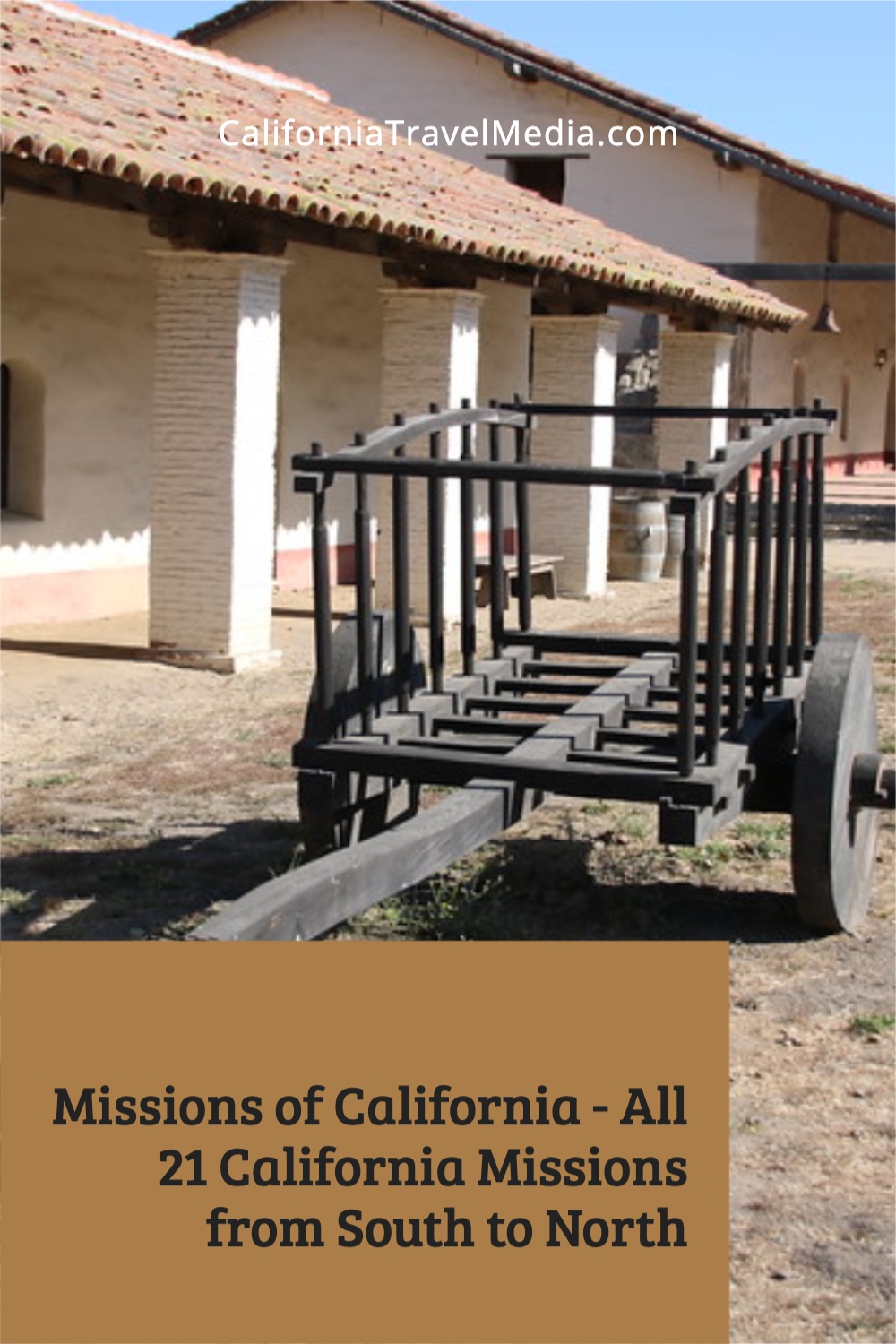
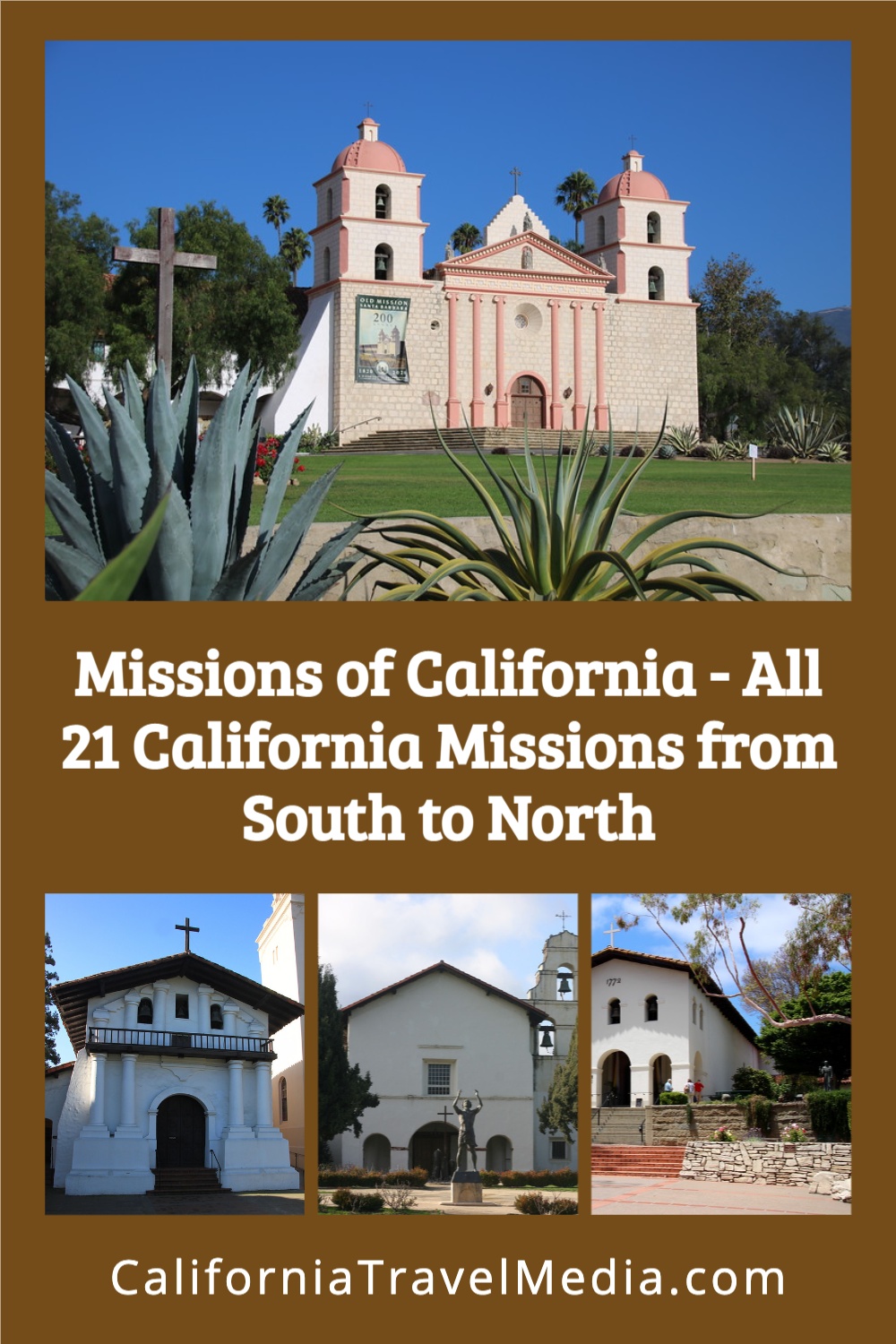
9 Responses to “Missions of California (with Map) – All 21 California Missions from South to North”
Leave a Reply
Tags: california missions, carmel, jolon, lompoc, los angeles, mission hills, san diego, san francisco, san gabriel, san juan bautista, san juan capistrano, san luis obispo, san luis rey, san miguel, san rafael, santa barbara, santa clara, santa cruz, soledad, solvang, sonoma, ventura




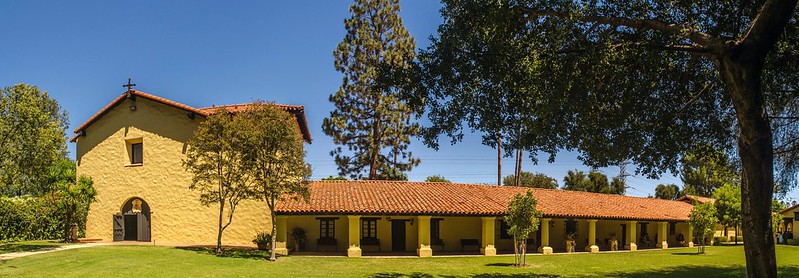



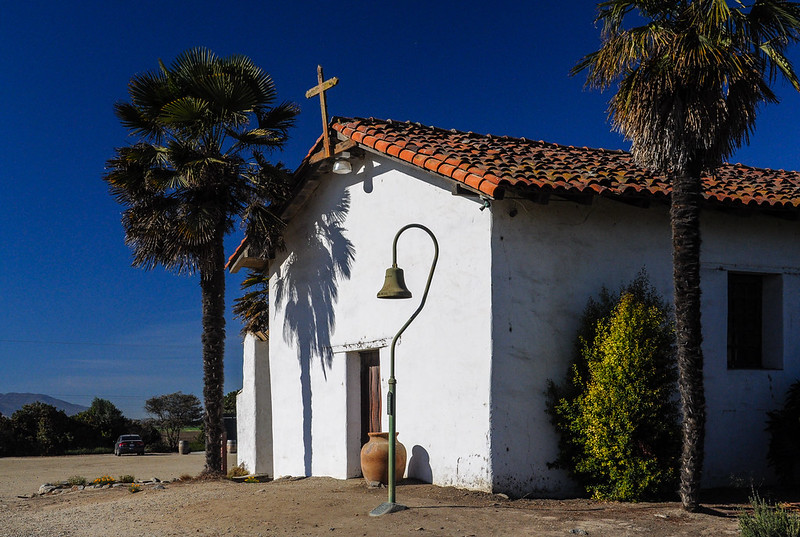

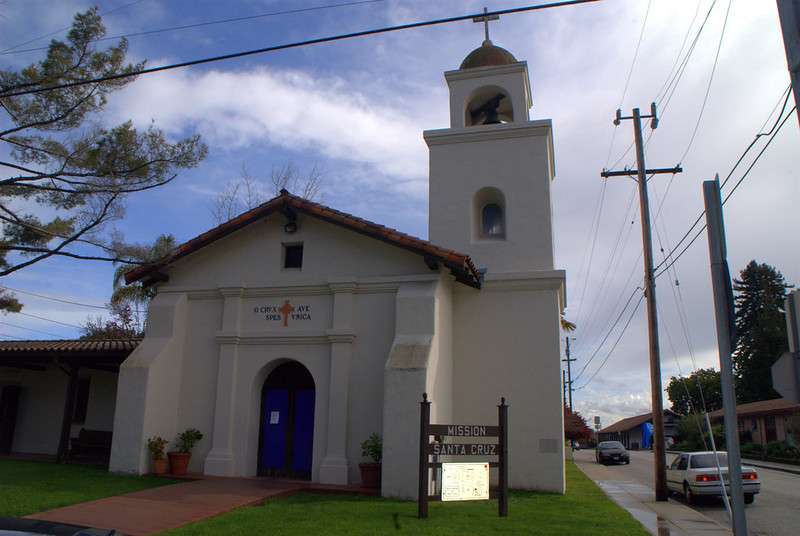


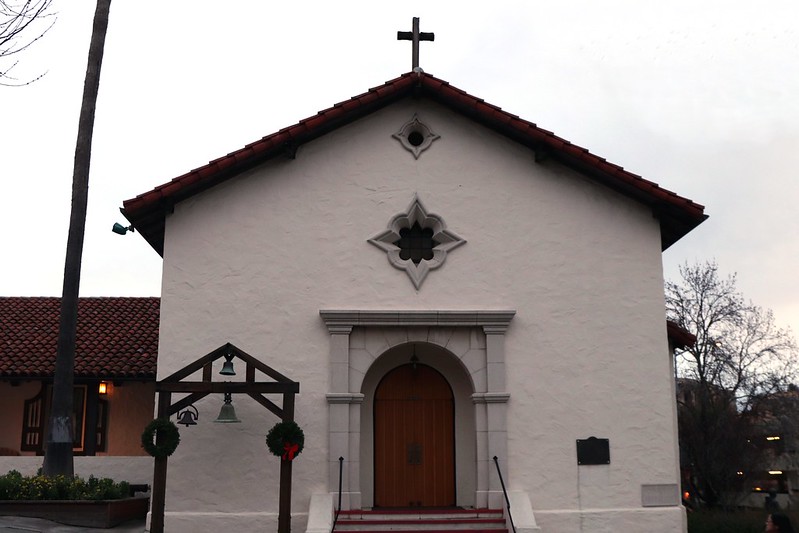



Ramon Castillo-Rabaneda
Says:May 7th, 2021 at 10:36 pm
We are beginning to plan a youth pilgrimage from New York to visit the most important Missions of California (I am from Spain) mid July.
How can we get this brochure, or how to print it?
Also, we would like to look for convent, monasteries, places where be hosted as pilgrims (No hotels) to experience a real pilgrimage. Do you have some information about lodging in some of the missions? We estiamted about 40/50 persons (1 bus) maximum
Thanks
Chris Christensen
Says:May 9th, 2021 at 10:39 am
You can print the blog post if you like… but there is no brosure.
Chris Christensen
Says:May 9th, 2021 at 10:39 am
You can print the blog post if you like… but there is no brochure.
Michelle Bobrow
Says:March 13th, 2024 at 4:54 pm
Thank you for the great information. After my son began his 4th grade project, I decided to research what it would take to do a vacation with the kids to see all the missions. We live about an hour and a half away from Sonoma so we would start backwards. This information is very helpful, and I think it is extremely important to learn about California history being we grew up and are from here. Important to know all aspects of the history. I am excited to plan this trip and honestly, I don’t know why I didn’t think of it sooner.
Chris Christensen
Says:March 14th, 2024 at 4:51 am
Awesome Michelle!
Susan
Says:June 24th, 2024 at 5:25 pm
Hello. Do you know if there is a map available that shows the driving times from Mission to Mission? How many can you see in one day?
We are thinking of doing all northern ones, and working our way down, and doing the 3 most southern ones on a different trip (we live in North Orange County.
Chris Christensen
Says:June 25th, 2024 at 2:43 pm
When they were originally built, the idea was that the missions were a days ride apart, so by car you can easily see more than one in a day… unless you are going on a horse.
Janet Brugman
Says:July 24th, 2024 at 8:39 pm
I was a California 4th grade student in 1963 and still remember building my mission project out or sugar cubes and corrugated cardboard which I painted red. I don’t remember which mission it was, though – oh well.
In 1976 my mother – who was a 4th grade public school teacher – took my sister, brother and I to see all 21 missions that summer. Not all of them had been restored, yet. I still remember that great trip
Thanks
Chris Christensen
Says:July 25th, 2024 at 2:43 pm
Awesome memories Janet, thanks for sharing. 🙂